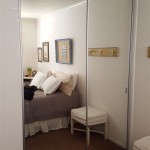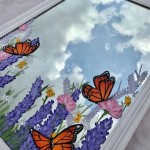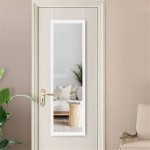How To Make Antique Mirror From Glass
Creating an antique mirror finish on modern glass allows one to incorporate the charm and character of aged décor into contemporary spaces. This process, while requiring patience and precision, can be accomplished with readily available materials and tools. This article will outline the necessary steps and considerations for achieving a convincing antique mirror effect.
Essential Materials and Tools
The following items are crucial for undertaking this project:
- Clean glass sheet (the desired size of the mirror)
- Mirror effect spray paint (silver or other metallic base)
- Antiquing solution (commercially available or homemade)
- Spray bottles (for applying solutions evenly)
- Protective gloves and eyewear
- Drop cloths or newspapers (to protect the work surface)
- Soft cloths (for applying and blending antiquing solution)
- Masking tape (optional, for creating patterns)
Preparing the Glass Surface
The glass must be impeccably clean to ensure proper adhesion of the mirror coating. Any dirt, grease, or residue will prevent uniform application and can lead to imperfections in the final product. Thoroughly cleaning both sides of the glass is essential for achieving a professional-looking result.
- Wash the glass with warm, soapy water.
- Rinse thoroughly with clean water.
- Dry completely with a lint-free cloth.
- Clean the glass with a glass cleaner for optimal results.
- Handle the cleaned glass by the edges to avoid leaving fingerprints.
Applying the Mirror Coating
Applying the mirror effect spray paint requires a controlled environment and careful technique. Even, consistent coats are essential for achieving a smooth, reflective surface. Rushing this process can lead to drips, streaks, or an uneven finish.
- Work in a well-ventilated area, preferably outdoors.
- Shake the mirror effect spray paint can vigorously according to the manufacturer's instructions.
- Hold the can approximately 10-12 inches from the glass surface.
- Apply thin, even coats, allowing each coat to dry completely before applying the next.
- Avoid over-spraying, which can cause runs and drips.
- Allow the final coat to dry thoroughly according to the manufacturer's instructions.
Creating the Antique Effect
This stage is where the artistry and customization come into play. The antiquing solution creates the aged appearance, and the application technique dictates the final aesthetic. Experimentation is encouraged to achieve the desired level of antiquity.
- Choose an antiquing solution. Commercially available options are readily available, or a homemade solution of vinegar and water can be used.
- Test the antiquing solution on a small, inconspicuous area of the mirrored surface to gauge the effect.
- Using a spray bottle or soft cloth, apply the antiquing solution to the mirrored surface.
- Dab or wipe with a clean, soft cloth to create the desired aged effect. Focus on the edges and corners for a more authentic look.
- Allow the antiquing solution to dry completely.
- Multiple layers of antiquing solution can be applied for a more pronounced effect.
Sealing the Antique Finish (Optional)
Sealing the finished antique mirror can protect the surface from wear and tear, ensuring longevity and preserving the desired aesthetic. This step is particularly recommended for mirrors that will be frequently handled or exposed to moisture.
- Choose a clear sealant appropriate for use on glass and mirror surfaces.
- Apply a thin, even coat of sealant, following the manufacturer’s instructions.
- Allow the sealant to dry completely before handling the mirror.
Tips and Considerations for Achieving Desired Results
Specific techniques can be employed to achieve different antique mirror effects. Varying the application of the antiquing solution can produce unique and customized results. The below tips will help ensure a successful project.
- For a more subtle, aged look, lightly mist the antiquing solution and gently dab with a soft cloth.
- To create a heavily antiqued appearance, apply the antiquing solution more liberally and allow it to react longer before wiping.
- Masking tape can be used to create patterns or borders before applying the antiquing solution for a more controlled effect.
- Varying the pressure applied while dabbing or wiping the antiquing solution will create different textures and patterns.
- Practice on a smaller piece of glass before working on the final project to gain confidence and refine the technique.
Safety Precautions
Working with chemicals and glass requires taking appropriate safety measures. Protecting oneself from potential hazards is crucial throughout the process.
- Always wear protective gloves and eyewear when working with chemicals and glass.
- Work in a well-ventilated area to avoid inhaling fumes from the spray paint and antiquing solutions.
- Dispose of used materials properly according to local regulations.

Diy Antique Mirror Easy To Do And Looks Authentic My Creative Days

The Ultimate Guide On Diy Antique Mirrors So Much Better With Age

The Ultimate Guide On Diy Antique Mirrors So Much Better With Age

How To Antique A Mirror Easy No Scratching The Navage Patch

Diy Antique Mirror Easy To Do And Looks Authentic My Creative Days

How To Antique A Mirror From The Front With Paint Average But Inspired

The Ultimate Guide On Diy Antique Mirrors So Much Better With Age

10 Tutorials On How To Antique A Mirror So Much Better With Age

How To Antique A Mirror 9 Fast Diys Shelterness

How To Antique A Mirror Easy No Scratching The Navage Patch








